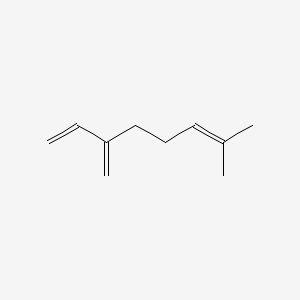| Authors | Title | Published | Journal | PubMed Link |
|---|---|---|---|---|
| Sandstrom P et al. | Functional expression of a bark beetle cytochrome P450 that hydroxylates myrcene to ipsdienol. | 2006 | Insect Biochem. Mol. Biol. | pmid:17046597 |
| Hao D et al. | [Analysis of volatile constituents in leaves of three cypress species by gas chromatography/mass spectrometry]. | 2006 | Se Pu | pmid:16830472 |
| Omura H et al. | From terpenoids to aliphatic acids: further evidence for late-instar switch in osmeterial defense as a characteristic trait of swallowtail butterflies in the tribe papilionini. | 2006 | J. Chem. Ecol. | pmid:16902823 |
| Choi HS | Lipolytic effects of citrus peel oils and their components. | 2006 | J. Agric. Food Chem. | pmid:16637681 |
| Johnson LM | Gitksan medicinal plants--cultural choice and efficacy. | 2006 | J Ethnobiol Ethnomed | pmid:16790066 |
| Kurobayashi Y et al. | Potent odorants characterize the aroma quality of leaves and stalks in raw and boiled celery. | 2006 | Biosci. Biotechnol. Biochem. | pmid:16636464 |
| Runyoro DK et al. | Screening of Tanzanian medicinal plants for anti-Candida activity. | 2006 | BMC Complement Altern Med | pmid:16571139 |
| Gomes-Carneiro MR et al. | Evaluation of beta-myrcene, alpha-terpinene and (+)- and (-)-alpha-pinene in the Salmonella/microsome assay. | 2005 | Food Chem. Toxicol. | pmid:15621337 |
| Chiang LC et al. | Antiviral activities of extracts and selected pure constituents of Ocimum basilicum. | 2005 | Clin. Exp. Pharmacol. Physiol. | pmid:16173941 |
| Choi HS | Characteristic odor components of kumquat (Fortunella japonica Swingle) peel oil. | 2005 | J. Agric. Food Chem. | pmid:15740053 |
Myrcene
Myrcene is a lipid of Prenol Lipids (PR) class. Myrcene is associated with abnormalities such as Hypomenorrhea, abnormal fragmented structure, Nephrosis, Renal tubular disorder and Kidney Diseases. The involved functions are known as Anabolism, Gene Expression, Protein Biosynthesis, Mutation and Selection, Genetic. Myrcene often locates in Plastids, Proboscis, Body tissue, Clone and soluble. The associated genes with Myrcene are TTPA gene, monoterpene synthase, Genome, 4S-limonene synthase and Homologous Gene. The related lipids are Pinene, Octanols, Membrane Lipids and Fatty Acids, Unsaturated.
Cross Reference
Introduction
To understand associated biological information of Myrcene, we collected biological information of abnormalities, associated pathways, cellular/molecular locations, biological functions, related genes/proteins, lipids and common seen animal/experimental models with organized paragraphs from literatures.
What diseases are associated with Myrcene?
Myrcene is suspected in Nephrosis, Kidney Diseases, Dehydration, Hypomenorrhea, Renal tubular disorder and other diseases in descending order of the highest number of associated sentences.
Related references are mostly published in these journals:
| Disease | Cross reference | Weighted score | Related literature |
|---|
No disease MeSH terms mapped to the current reference collection.
PubChem Associated disorders and diseases
What pathways are associated with Myrcene
There are no associated biomedical information in the current reference collection.
PubChem Biomolecular Interactions and Pathways
Link to PubChem Biomolecular Interactions and PathwaysWhat cellular locations are associated with Myrcene?
Visualization in cellular structure
Associated locations are in red color. Not associated locations are in black.
Related references are published most in these journals:
| Location | Cross reference | Weighted score | Related literatures |
|---|
What functions are associated with Myrcene?
Related references are published most in these journals:
| Function | Cross reference | Weighted score | Related literatures |
|---|
What lipids are associated with Myrcene?
Related references are published most in these journals:
| Lipid concept | Cross reference | Weighted score | Related literatures |
|---|
What genes are associated with Myrcene?
Related references are published most in these journals:
| Gene | Cross reference | Weighted score | Related literatures |
|---|
What common seen animal models are associated with Myrcene?
There are no associated biomedical information in the current reference collection.
